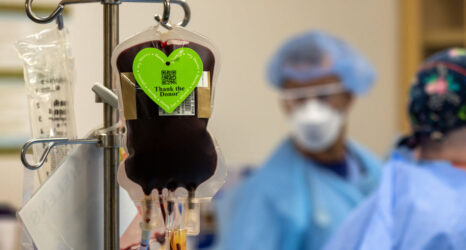Early in the morning on a sunny spring day, I met my friend Dora at the Port Authority in Manhattan. There we boarded a bus that would take us to a small town in New Jersey, and a doctor’s office where Dora had arranged to have an abortion.
It was 1966, I was 21, and what we were doing was illegal and dangerous.
In 1966, women had to scramble for help if they wanted to terminate a pregnancy, and often ended up in dirty back rooms with people who didn’t know what they were doing. Back then, a lot of women ended up sick or injured. Some died. Dora was lucky: She had found a doctor who performed abortions in the mornings, in his office, assisted by a nurse.
The ride took about an hour, through the west side of Manhattan and the Lincoln tunnel and into eastern New Jersey, where we found ourselves—two silent, frightened young women—in a small working-class town, with rows of houses that looked alike: two-stories, red brick, tiny alleys, no yards.
The doctor’s office was on the first floor of a house in the middle of the block. We entered through a glass-enclosed vestibule and rang the bell. A stern-faced nurse, in white uniform and cap, answered the door and motioned us in to an ordinary waiting room. Inside, the shades were drawn and the lamps were turned off, but in the morning light I could see chairs and sofa, a rug on the floor, prints of flowers on the walls. Three women who looked a lot like Dora and me—young, white, scared—were sitting quietly, and we joined them. A dim hallway off the back of the waiting room led to the inner rooms, where the doctor was and where the abortions were performed.
From where I sat, I could see the shadows of others as they entered the vestibule and rang the bell, and right after us three more women arrived and then two more. In all, 10 abortions were scheduled for that morning. The nurse told everyone to be quiet and leave the lights off. The abortions took about 10 to 15 minutes, she said, and afterwards the women would rest in the recovery room for a short while before coming back out to the waiting room, where they would continue to recover, and then leave as soon as they could.
It was an efficient system, designed to take as short a time as possible, and it depended on there being no complications. But of course, there were complications: some women were more pregnant than they had thought, some took longer to recover, some procedures ran into unexpected difficulty. The women needed to leave as soon as possible, so were given only mild sedation and local anesthesia and no medication for pain.
The hallway was short. I could hear sounds from the back: mumbled voices, rustling, a chair scraping the floor. Soon a woman emerged, slightly older than the rest of us, care worn, skinny. She was woozy and unsteady and sank into a chair, closed her eyes and took a deep breath. She sat like that for a while, then got up, wrapped her arms around her belly, and began walking around the room, once, twice, three times, slowly at first and then a little faster until she seemed stronger and more alert—and finally, after a last deep breath, was able to gather her things and leave. In the meantime, the nurse called another woman and led her to the back.
All morning, as I waited with Dora, I watched as women were taken inside for their abortions. Most were in back for about 30 minutes and emerged dazed and weak. They sat for a while, and then walked around the room for a few minutes until they felt they could leave, willing themselves out the door, still shaky, still in pain. There was no conversation. The room was quiet. But we could hear voices and sometimes crying from the back, crying that made me look up and hold my breath until it stopped.
Dora was one of the last women seen that day. She was in back for about 20 minutes, shorter than most, and emerged pale and shaky. She sat next to me, clutched her belly, closed her eyes and breathed deep. We didn’t talk, but when she rose to begin circling the room, I rose too, put my arm around her shoulder and walked with her for a while. When she seemed stronger, I sat and watched her.
The morning passed in a blur, slow then fast then slow again. I had no sense of time or of how long I sat there, and so when I heard someone enter the vestibule and try to open the door to the waiting room, I looked up, saw the shadow of a man, and froze. He tried the door a couple of times, then rang the bell. The nurse came back out to the waiting room, her mouth set in a taut line, and it was suddenly clear that the doctor was running late and his afternoon patients were beginning to arrive.
The last woman to be seen was still in back. Another, who had her abortion after Dora, was walking slowly around the waiting room. And the situation, which had seemed to me so well organized and careful—safe even—was all at once terrifying.
The nurse went back down the hallway, signaling us to be quiet. Two more afternoon patients arrived. They stood in the vestibule, rang the bell, tried the door. I could see their shadows as they tried to peer inside. I could hear them talking to each other: What’s going on? Why is the door locked? How long have you been waiting?
The last woman came back out to the waiting room with the nurse, who whispered that we would all need to leave together, right away. And so, three women, post-abortion by only minutes, tried to get ready to go. In pain, exhausted, shaking with fear, no one was ready to go anywhere—but quietly and slowly, they got up, smoothed their skirts, put their coats on and grabbed their bags.
The nurse organized all of us into some sort of cohesive unit. She waited a few minutes more before she unlocked the door and motioned for us to go. A tightly wound group of four, we walked together out the door, past the other patients and back onto the sunny streets of East Jersey.
Now, more than 50 years later, while many details of that day have faded, the walk through the vestibule is still vivid. I watched my feet and barely breathed. I felt the sun’s strong rays and the heat of that tiny space. I felt the silent, staring presence of the other patients. Only three steps, but the time expanded, and those three steps and that small space remain etched in my memory.
I went to see Dora a couple of weeks later. We talked for a few minutes in the hallway outside her apartment. She was thin and pale, she was unhappy and angry, but she didn’t want to talk, and after a short while I left.
I don’t know what happened to Dora. I don’t know what became of the competent nurse or the unseen doctor. I don’t know what happened to any of the women I saw that day in New Jersey. They were the lucky ones, able to find a legitimate doctor to help them—but the stigma, the secrecy, the fear and danger and the deep pain was theirs alone.





